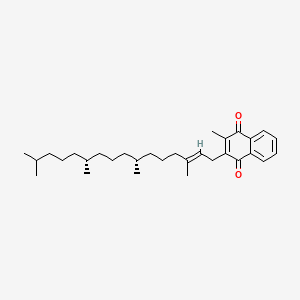| MeSH term | MeSH ID | Detail |
|---|---|---|
| Exanthema | D005076 | 11 associated lipids |
| Thromboembolism | D013923 | 6 associated lipids |
| Vitamin K Deficiency | D014813 | 5 associated lipids |
phylloquinone
Phylloquinone is a lipid of Prenol Lipids (PR) class. Phylloquinone is associated with abnormalities such as Vitamin K Deficiency, Malnutrition, Consumption-archaic term for TB, Osteoporosis and Hyperostosis, Diffuse Idiopathic Skeletal. The involved functions are known as Ingestion, Blood Circulation, Genetic Polymorphism, Intestinal Absorption and Process. Phylloquinone often locates in Blood, Body tissue, Hepatic, Membrane and Entire bony skeleton. The associated genes with phylloquinone are Vitamin K Epoxide Reductase Complex, Subunit 1, GGCX gene, CYP4F2 gene, Alleles and APOE gene. The related lipids are Micelles, 208-G, Fatty Acids, Total cholesterol and Sphingolipids. The related experimental models are Knock-out.
Cross Reference
Introduction
To understand associated biological information of phylloquinone, we collected biological information of abnormalities, associated pathways, cellular/molecular locations, biological functions, related genes/proteins, lipids and common seen animal/experimental models with organized paragraphs from literatures.
What diseases are associated with phylloquinone?
phylloquinone is suspected in Vitamin K Deficiency, Diabetes Mellitus, Non-Insulin-Dependent, Diabetes, vitamin depletion, Malnutrition, Osteoporosis and other diseases in descending order of the highest number of associated sentences.
Related references are mostly published in these journals:
| Disease | Cross reference | Weighted score | Related literature |
|---|
Possible diseases from mapped MeSH terms on references
We collected disease MeSH terms mapped to the references associated with phylloquinone
PubChem Associated disorders and diseases
What pathways are associated with phylloquinone
There are no associated biomedical information in the current reference collection.
PubChem Biomolecular Interactions and Pathways
Link to PubChem Biomolecular Interactions and PathwaysWhat cellular locations are associated with phylloquinone?
Visualization in cellular structure
Associated locations are in red color. Not associated locations are in black.
Related references are published most in these journals:
| Location | Cross reference | Weighted score | Related literatures |
|---|
What functions are associated with phylloquinone?
Related references are published most in these journals:
| Function | Cross reference | Weighted score | Related literatures |
|---|
What lipids are associated with phylloquinone?
Related references are published most in these journals:
| Lipid concept | Cross reference | Weighted score | Related literatures |
|---|
What genes are associated with phylloquinone?
Related references are published most in these journals:
| Gene | Cross reference | Weighted score | Related literatures |
|---|
What common seen animal models are associated with phylloquinone?
Knock-out
Knock-out are used in the study 'A dedicated thioesterase of the Hotdog-fold family is required for the biosynthesis of the naphthoquinone ring of vitamin K1.' (Widhalm JR et al., 2009) and Knock-out are used in the study 'Deficiency in phylloquinone (vitamin K1) methylation affects prenyl quinone distribution, photosystem I abundance, and anthocyanin accumulation in the Arabidopsis AtmenG mutant.' (Lohmann A et al., 2006).
Related references are published most in these journals:
| Model | Cross reference | Weighted score | Related literatures |
|---|
NCBI Entrez Crosslinks
All references with phylloquinone
Download all related citations| Authors | Title | Published | Journal | PubMed Link |
|---|---|---|---|---|
| Park BK et al. | The dose-dependent effect of warfarin on vitamin K1 metabolism and clotting factor synthesis in the rabbit. | 1980 | Biochem. Pharmacol. | pmid:7396990 |
| Meeks RG and Couri D | Inhibition by warfarin of prothrombin synthesis and of lipid-saccharide synthesis in rat liver. | 1980 | Biochim. Biophys. Acta | pmid:7388053 |
| Elliott GR et al. | Assay procedure for the vitamin K1 2,3-epoxide-reducing system. | 1980 | Meth. Enzymol. | pmid:7366422 |
| Nakata H and Tsuchida E | Determination of vitamin K1 in photodegradation products by gas-liquid chromatography. | 1980 | Meth. Enzymol. | pmid:7366421 |
| Robison JW and Odom RB | Delayed cutaneous reaction to phytonadione. | 1978 | Arch Dermatol | pmid:736587 |
| Carter A et al. | Multiple acquired haemostatic defects. Case report and review of the literature. | 1980 | Haemostasis | pmid:7358321 |
| Sherman PA and Sander EG | Vitamin K epoxide reductase: evidence that vitamin K dihydroquinone is a product of vitamin K epoxide reduction. | 1981 | Biochem. Biophys. Res. Commun. | pmid:7332587 |
| Kolb E | [Recent discoveries on the biochemical significance of vitamin K and some characteristics of vitamin K dependent proteins]. | 1981 | Z Gesamte Inn Med | pmid:7331379 |
| Takahashi O and Hiraga K | Inhibition of phylloquinone epoxide-dependent carboxylation of microsomal proteins from rat liver by 2,6-di-tert-butyl-4-methylene-2,5-cyclohexadienone. | 1981 | Food Cosmet Toxicol | pmid:7327471 |
| Carlisle DM and Blaschke TF | Vitamin K1, vitamin K1 epoxide and warfarin interrelationships in the dog. | 1981 | Biochem. Pharmacol. | pmid:7317089 |
